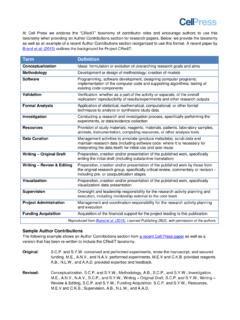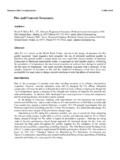Transcription of Neuronal cell types
1 MagazineR497 PrimerNeuronal celltypesRichard H. MaslandIdentifying the functionallydistinct types of neuron is centralto any bottom-up understandingof how the brain works. Thedifferent cell types are the brain selementary computationalelements the components fromwhich the larger machine ismade. We have known of somecell types for more than acentury, but the coverage hasbeen spotty and anecdotal. Thisis changing: it is now possible toassemble more or less completeinventories of cell types thebrain s parts list, upon which allunderstandings of brain recognition that neuronsare distinct functional entitieswas the first great contribution ofneurobiology s founding father,Santiago Ramon y Cajal, whocould make that leap because hehad a method, the Golgi stain,which shows individual neuronsin spectacular isolation from theirneighbors.
2 It was immediatelyapparent that neurons come in aflorid variety of shapes and theidentification of Neuronal types ,an industry that still flourishes,was set in motion. How areneuronal types distinguished andwhy do neurobiologists care somuch about them?Distinguishing cell typesWhat do we mean by a cell type?This question has generatedmuch tedious discussion, but theultimate goal is simple to find away to single out a group ofneurons that carry out a distincttask. In real life, we rarely know acell s function at the firstencounter, and the strategic pathis to first identify cell types andthen find out what they do. Thiskind of search is based on thefundamental premise thatdifferent structure indicatesdifferent function, structure broadly defined here to includeboth morphology and theexpression of functionallyimportant proteins.
3 This hasproved over the years to be areliable rule (a doubtful reader isinvited to search for acounterexample). Variation in almost anybiologically important dimensioncan be taken as a , cell types can bedistinguished by their expressionof genes and/or they are firstdistinguished by characteristicpatterns of electrical activity. Butthe commonest way is the shapeof the cell. This is not onlybecause the shapes of neuronsare pretty which to the trainedeye they are nor is cell shapejust a convenient taxonomiclabel. The deeper reason is thatthe shapes of neurons are adirect reflection of their a hypotheticalstructure (nucleus) within thebrain, containing three layers ofaxonal inputs and two groups ofneurons contacted by them(Figure 1).
4 In the illustration, theinputs run horizontally across thenucleus at three different now that the three levelsof inputs that define theunderlying reality are invisible, sothat the shapes of the neuronsare the only things that can beobserved. It is still quite possibleto identify the cells as distinctentities. For convenience,neuroanatomists from Cajal stime to the present have giventhem evocative nicknames, asshown in Figure 1B, but this isonly a mnemonic device. Whatmatters is that the shapes reflectan underlying connectivity. Thecell types not only serve todistinguish one type of cell fromanother, they are the first steptoward understanding theunderlying differences between celltypes are sometimes obvious toeven an untrained eye, butseeing them more often takespractice.
5 Also, there have beenfew methods that, like the Golgistain, reveal the entire shape of aneuron without interference fromits intertwined much fanfare, molecularbiology and digital imagingtechnology have nowrevolutionized the visualization ofcell shapes. Not only are theremyriad ways to stain solitarycells, but we see them much,much better than biologists ofeven a decade ago: we see themin all their three-dimensionalglory, where the optics availableto Cajal gave essentially a two-dimensional view. Many so-called transition cases cellsthat appeared intermediatebetween types turn out to bedue to experimental noise andblur, once modern staining andoptics are types and subtypesThere are hundreds of namedneuronal types in the brain.
6 Thenames have varying degrees ofexactness and currency, rangingfrom the famously distinctivePurkinje cell to many lesser,poorly defined cells . Like genes,some cells appear under severalnames. Often, earliernomenclatures have beenabandoned as more precise waysof classifying cells developed. Infortunate cases a name derivedfrom morphology, such as sparse, wide-field multistratifiedcell , is replaced by one derivedfrom a unique cell-type-specificprotein, such as melanopsincell , but these are for genes, names aresometimes chosen whimsically,and as for genes it is unlikely thata standard system of naming willexist particularly unfortunate pieceof vagueness pertains to thehierarchy of groups. Terms like variety , class , type , subclass , and subtype areused indiscriminately.
7 Thetechnically correct usage isperhaps for a class to representa collection of types that share acommon feature. In this usagethere is no place for a subclass indeed, there isprobably a need for moretaxonomic levels. The term type is sometimes reserved for theterminally differentiated level, andthat usage will be followed functionally important andwidely agreed-upon distinction isbetween projection neurons,which send an axon out of thestructure where their soma islocated, and intrinsic neurons,which make synapses only withinthe structure where their soma islocated. (Alternative terms are principal cells and interneurons , respectively.) Notethat the distinction applies onlyto the cell s axonal projection,not to the source of its inputs: anintrinsic neuron can receivesynaptic inputs from cells locatedwithin the same structure or fromdistant ones.
8 The followingparagraphs give examples ofneuronal types in the cerebellumand the retina, where the typesare pretty well understood, andthe neocortex, which has proveda much harder nut to of the cerebellumThe cerebellum has long been apopular model system, in largepart because of its orderly andrelatively simple architecture. Itcontains a single type ofprojection neuron, the Purkinjecell (Figure 2). Not only do theseneurons have a highlystereotyped architecture, butthey are essentially twodimensional they havesomewhat the shape of a makes them easy toconceptualize and easy of accessfor cerebellum contains fivemain types of intrinsic cells have tiny cellbodies (5 8 m) and smalldendritic arbors (~50 mdiameter), but send an axon thatruns for millimeters within thecerebellum.
9 The granule cells aretightly packed and thecerebellum is large; in absoluteterms, they are the mostnumerous single type of neuronin the nervous system. Two otherinterneurons are the basket andstellate cells . The Golgi cells named for their discoverer,Camillo Golgi, not for his stainingmethod are much larger, withdendritic arbors that span alllevels of the cerebellar of the neocortexThis simple list of cerebellarneurons, and the images ofisolated cells in Figure 2, mustunfortunately ignore thegorgeous architecture with whichthe cells are interlaced thebrain as Sherrington s greatenchanted loom . The neocortexsurely has a similar orderliness,were we to understand it, but inthe neocortex the overall plan isless obvious and the taxonomy ofthe Neuronal types much lessclear.
10 In contrast to thecerebellum (or the retina, seebelow), projection neurons in theneocortex outnumber intrinsicneurons, making up about 80%of all cortical neurons. Thisdifference may occur becauseprojection neurons of theneocortex, in contrast to those ofthe cerebellum or retina, oftensend axon collaterals thatterminate within the cortex. Thismeans that they have a localcircuit function as well ascommunicating with the brain sdistant major class of projectionneurons in the neocortex are thepyramidal cells . They have a widevariety of shapes andprojections. Their cell bodies canbe located in any of the corticallayers except layer 1. Many,though possibly not all, pyramidalcells project to distant term pyramidal cell is usedfor neurons in several brainstructures (there arehippocampal pyramidal cells ) andgenerally denotes a large cellwith a roughly triangular somafrom which arise distinct sets ofapical and basal dendrites.












